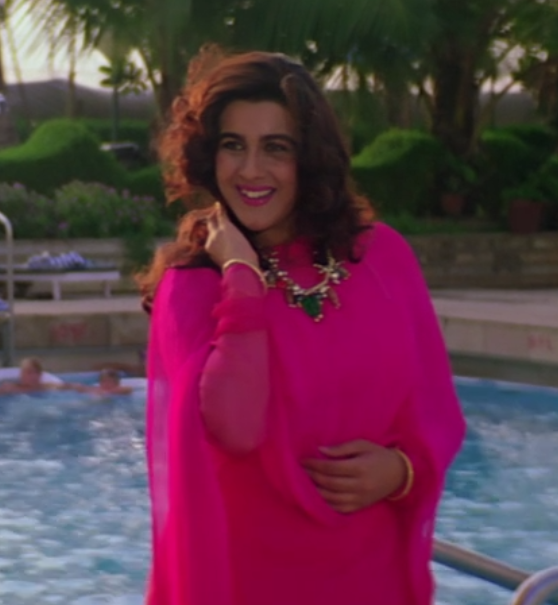During the lockdown I decided to watch my aunt’s favourite film, Aaina (1993). Normally I don’t review classic Bollywood because it doesn’t aim for authenticity as much as novelty and visual spectacle. With the caveat of course that often “filmi” styles do percolate down to mass wear.
But as it happens, Aaina in parts made me quite nostalgic as I was a young person in the 90s and remember more than a few of the trends. And I was pleasantly surprised by the way the movie uses clothes to create a persona.
The ensemble cast of this movie is on good form but the star of the film is definitely Amrita Singh. And her high voltage act is definitely helped along by some strong statement outfits which Amrita carries with aplomb. In fact it felt like much of her single, bold colour palette is what we are seeing of late. Almost throughout Amrita’s character wears clothes that are vividly coloured with chunky accessories, making her the central point of the scene. The clothes convey to the viewer her headstrong single mindedness as well as her confidence and allure. When she does wear pattern, it is usually housewear with large motifs.






In contrast, Juhi Chawla, as the mousy and moral sister, wears a more subdued palette though it brightens up a bit post marriage. The interesting thing for me was that a lot of her clothes were surprisngly relatable, I remember similar stuff in the shops back in time.
The 90s tended to favour over-large yoke patterns for kurta, the embroidery also tended to rely on larger elements as opposed to the more delicate, finer work you may see today. See for example the kurta of pic 1 here. It was also the era of suit sets which meant that dupattas were a given.





One of the interesting style choices of the movie was Juhi Chawla’s hair ties. I don’t remember these from back in time but they definitely give her chracter’s everygirl persona a quirky, individualistic twist.



A few screengrabs of the full outfits. Now that I think of it the A-line/fit-and-flare kurtas of this era anticipate the full on volume of the Anarkalis of the 21st century. As the last pic shows, most of Juhi’s outfits have a narrow salwar while Amrita’s outfits are flowing chiffony kurtas worn often with a chudidar.







On to the sarees. Amrita’s sarees – again single tone – are worn seedha pallu style. I don’t remember if this was a trend but the style is of course there in Hum Aapke Hain Koun too. There are a few short tunic sort of blouses too, the character marching to her own beat as it were.



Juhi’s character wears a lot of sarees post her marriage midway through the film. One of the things to note is that this decade saw the “saree with blouse piece” trend. In fact it was a very matchy-matchy decade with everything from blouse to bindi to bangles colour co-ordinated, I knew girls who dressed like this on a daily basis (Bhargavi, Nisha where are you!). Of the sarees, a fair few seem to be handloom, the pink is definitely Odisha. The white and black saree is I think a Comibatore saree which were quite popular – my mother had a few. Lastly, I think this was also the decade of the black bead mangalsutra – of course sindoor was around – but black beads were popular signifiers of marital status and you could get different styles as opposed to the traditional design.





And of course there is the 90s bindi, with all the crystals and glitter, the matching bangles and a very 90s photoshot featuring a hat. There is also that lipstick matching the cravat detail:). In fact Jackie Shroff has some pretty flamboyant and colourful outfits as do some of the other younger male characters. The male style in this decade was generally a little loose and boxy, even for the formal clothes.





A bit about the design and settings. This movie has several interior shorts and given that it takes place in a well-off milieu, the houses are big and let’s say a bit over-decorated. Nevertheless they do reflect the families, the sisters’ house a little smaller and cluttered, with darker colours (last pic) and the more light filled interiors of Jackie Shroff’s house with a lot of whites, corals and house plants. And two B. Prabha paintings also make an appearance:).




In sum, the movie is a soap opera with effective performances that make it reasonably entertaining viewing. As the post shows, within a format which must offer the viewer visual escape, costume can play an important role in establishing the characters. This film combines everyday elements and glamour quite effectively – looking back movies like these shaped the evolving fashion sensibilities of liberalising India as well as a more visible diaspora. The movie thus belongs to an era that established “Bollywood fashion”, often drawing from North Indian aesthetic and lifestyles. We may not wear these styles anymore but it’s appeal lies in the fact that it is the last decade before globalisation and travel changed the way we dress (on screen and off) significantly.
COSTUME CREDITS: Neeta Lulla and Anna Singh.

